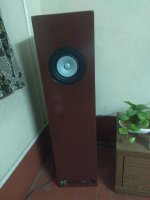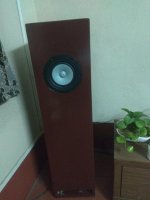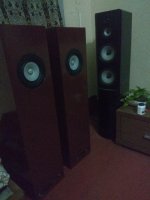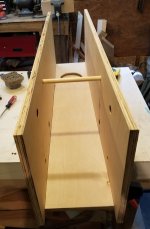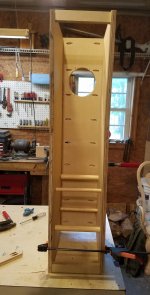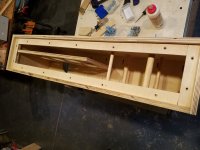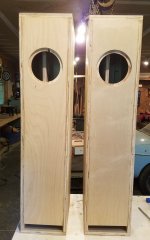I finally finished my Alpair 10p pensils...i stuffed them less than recommend polyfill....the bass seems flabby and sometimes overwhelming and affecting the mids. If i increase the stuffing....what change in sound quality i can expect? Will the bass become more impactful and tight and more details i will be able to hear??
Here are some pictures of my build
Here are some pictures of my build
Attachments
One more thing which i forgot to mention..i have used felt like material on back and both the side walls in the inside of the cabinets....and i am not sure but i think the sound is losing some details and highs...
If anyone can suggest me regarding this..it will be very helpful...
If anyone can suggest me regarding this..it will be very helpful...
To affect the mids & tops you need to have too much damoing, too close to the back of the driver.
Do not be tempted to do real listening evaluations & tweaks until you have at least a 100 real-world hrs on A10- drivers (for those with A10.3, 500 is probably a more realistic point).
dave
Do not be tempted to do real listening evaluations & tweaks until you have at least a 100 real-world hrs on A10- drivers (for those with A10.3, 500 is probably a more realistic point).
dave
I have adjusted the stuffing and the speakers sound very nice and retrieving lots of details after 100 hours burn in. My only gripe is the top end...which is hot..much more than what i like. Is there any way other than toe in or out to address this? Adding some layers of foam just behind the driver can help? Please guide and help me regarding this.
High frequencies are produced by the front of the driver, not the rear, so placing damping material in the enclosure will not affect them, unless in sufficient quantities / proximity to the cone that the air mass-loads the moving components and prevents them moving / resonanting as designed. Not a good policy.
Like many wideband drivers, it has a rising on-axis response to make it usable over a wider listening angle & is not really meant for listening directly on-axis, so adjusting the toe angle is the simplest & cheapest method of adjusting the HF balance. If you can't do that, then you will need EQ, be it active or passive electrical, or mechanical, either in the form of grills built up out of layers of cloth until you achieve the desired result (which is reversible), or physically damping the driver (which usually isn't).
Like many wideband drivers, it has a rising on-axis response to make it usable over a wider listening angle & is not really meant for listening directly on-axis, so adjusting the toe angle is the simplest & cheapest method of adjusting the HF balance. If you can't do that, then you will need EQ, be it active or passive electrical, or mechanical, either in the form of grills built up out of layers of cloth until you achieve the desired result (which is reversible), or physically damping the driver (which usually isn't).
My only gripe is the top end...which is hot..much more than what i like.
That is an unusual comment with respect to the A10p which has a top end i describe as vintage. Others would say soft.
What other kit are you using. Pics in room?
dave
Thank you all for your opinions and suggestions...I took into account what you guys said and i observed that my gripe about top end is only true in case of some recordings and mastering which were not upto the mark ... So i guess the speaker drivers cant be blamed on that part.
An Alpair 10p pencills attempt
Somewhere around last Christmas i got a Marantz 2226 as a present for my wife and to match the amplifier i build a pair of Alpair 10p CGRs.
Impressed by their sound I've decided to build a pair of pencils with the same drivers to pair with my Prima Luna Prologue.
Although this wasn't my first rodeo with DIY speakers I've still gave a good read to all the posts here. I have build BRs, TQWTs and OBs but i have never heard MLTL / Pencils before. I wasn't familiar with their sound signature and i didn't know what to expect.
A month ago i ordered top quality 21mm Baltic birch to be cut to the exact measures, i have chosen for a slightly thicker material in order to avoid the internal bracing and to keep the build as simple as possible. The driver cutout got CNCed perfectly down to mm. For the filling material I've ordered polyester wool sheets in 7mm thickness. They are easier to handle when experimenting with the amount and the placing of the damping material.
I did add a small cross section as brace in order to give one more point where all the sides are bond together and to stiffen the lower part of the baffle.
After i was finished with the building i wasn't satisfied with the sound at all. the drivers had good burn in period of over 1000 hour so that wasn't the problem. Soon i discovered that in order to preserve the 10p's original tonal balance behind and around its cone area there must be enough distance from the damping material, otherwise you get a nasty peak in the upper mid range. After adjusting that, the things improved but not quite enough to make me satisfied. After substantial hours with stuffing experimentation i decided to take another approach.
I arranged the stuffing in such manner that the driver will have similar behavior to what we see in the manufacturers frequency plot. Than i noticed where the problem was. There's this rise of couple db starting just under 2khz end ending aground 5khz. That's when i decided to try to smooth that region with a notch filter.
I had some crossover parts from my previous builds i calculated what will work the best with the values that i had on the hand. The result? Well, i couldn't hoped for a better sound. There was unbelievable better sound in all terms: The low region grew some balls (i don't know if i can use this word here but i use it in descriptive manner and not to offend someone), the mid range got some blood and flesh on it and the treble got more refined and extended than before. Maybe the sound-stage got a bit narrower and the SPL lost a db or two, but for the overall improvement of the sound it was more than fair compromise. Fore the purists "no passive components in the signal path" believers i must point that after placing the notch filter the detail retrieval ability of the Alpair 10p increased by quite a margin.
I note these thoughts as a thanks to Scottmoose for offering his design as freeware.
The Notch filter i used was R3/C10/L0,22 in series with the driver.
Here are some photos from my build :
Somewhere around last Christmas i got a Marantz 2226 as a present for my wife and to match the amplifier i build a pair of Alpair 10p CGRs.
Impressed by their sound I've decided to build a pair of pencils with the same drivers to pair with my Prima Luna Prologue.
Although this wasn't my first rodeo with DIY speakers I've still gave a good read to all the posts here. I have build BRs, TQWTs and OBs but i have never heard MLTL / Pencils before. I wasn't familiar with their sound signature and i didn't know what to expect.
A month ago i ordered top quality 21mm Baltic birch to be cut to the exact measures, i have chosen for a slightly thicker material in order to avoid the internal bracing and to keep the build as simple as possible. The driver cutout got CNCed perfectly down to mm. For the filling material I've ordered polyester wool sheets in 7mm thickness. They are easier to handle when experimenting with the amount and the placing of the damping material.
I did add a small cross section as brace in order to give one more point where all the sides are bond together and to stiffen the lower part of the baffle.
After i was finished with the building i wasn't satisfied with the sound at all. the drivers had good burn in period of over 1000 hour so that wasn't the problem. Soon i discovered that in order to preserve the 10p's original tonal balance behind and around its cone area there must be enough distance from the damping material, otherwise you get a nasty peak in the upper mid range. After adjusting that, the things improved but not quite enough to make me satisfied. After substantial hours with stuffing experimentation i decided to take another approach.
I arranged the stuffing in such manner that the driver will have similar behavior to what we see in the manufacturers frequency plot. Than i noticed where the problem was. There's this rise of couple db starting just under 2khz end ending aground 5khz. That's when i decided to try to smooth that region with a notch filter.
I had some crossover parts from my previous builds i calculated what will work the best with the values that i had on the hand. The result? Well, i couldn't hoped for a better sound. There was unbelievable better sound in all terms: The low region grew some balls (i don't know if i can use this word here but i use it in descriptive manner and not to offend someone), the mid range got some blood and flesh on it and the treble got more refined and extended than before. Maybe the sound-stage got a bit narrower and the SPL lost a db or two, but for the overall improvement of the sound it was more than fair compromise. Fore the purists "no passive components in the signal path" believers i must point that after placing the notch filter the detail retrieval ability of the Alpair 10p increased by quite a margin.
I note these thoughts as a thanks to Scottmoose for offering his design as freeware.
The Notch filter i used was R3/C10/L0,22 in series with the driver.
Here are some photos from my build :
Attachments
-
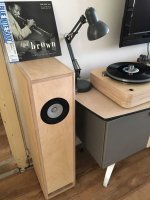 6AC5C056-F11A-4151-9234-F1515E0D451F_1_105_c.jpeg63.8 KB · Views: 476
6AC5C056-F11A-4151-9234-F1515E0D451F_1_105_c.jpeg63.8 KB · Views: 476 -
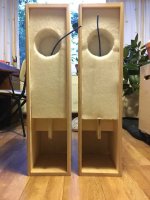 0FF9431A-CB4C-4D68-991B-91AF74573514_1_105_c.jpeg65.3 KB · Views: 532
0FF9431A-CB4C-4D68-991B-91AF74573514_1_105_c.jpeg65.3 KB · Views: 532 -
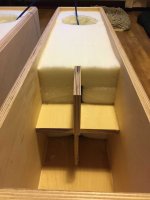 93524542-E38E-46DB-A124-F813B8B12253_1_105_c.jpeg46.3 KB · Views: 517
93524542-E38E-46DB-A124-F813B8B12253_1_105_c.jpeg46.3 KB · Views: 517 -
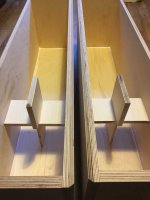 EF4A1C56-A2CA-40C9-92FC-DEBA08840B11_1_105_c.jpeg54.2 KB · Views: 498
EF4A1C56-A2CA-40C9-92FC-DEBA08840B11_1_105_c.jpeg54.2 KB · Views: 498 -
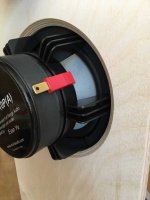 B0F274D2-2574-4155-9132-F19D7CD52869_1_105_c.jpeg52.6 KB · Views: 508
B0F274D2-2574-4155-9132-F19D7CD52869_1_105_c.jpeg52.6 KB · Views: 508
Another Pensil 10.3
Recently a friend of mine who is a woodworker put up with me in his shop as he built a pair of pensils for me. The pictures attached show the adjustments we made. Once they are painted, I'll post another picture. Since I was trying sensitive of his time we made one compromise and that was in using dowel rods for bracing in the lower part of the boxes. We drilled holes about 3/8" deep for the dowels and glued and clamped them til dry. I probably could have cut more holes for the holey braces. My friend used pocket screws and glue to put the boxes together. When it came time to fit the drivers against the brace we hand sanded a bit at a time until the fit seemed firm but not stressing the speaker. I stuffed as prescribed with teased polyfill. With about 700 hours on the speakers I am impressed. I use a linux computer to stream .wav and flac files into a Topping D10 DAC to my Millett DCPP amplifier. Both the amp and speakers are very revealing. While they do okay with rock or orchestra they really shine with small, close mic'd music such as concertos, jazz, soloists, etc. Since that is the music I tend to listen to I am one happy camper. I need to paint them just trying to decide what color.
Recently a friend of mine who is a woodworker put up with me in his shop as he built a pair of pensils for me. The pictures attached show the adjustments we made. Once they are painted, I'll post another picture. Since I was trying sensitive of his time we made one compromise and that was in using dowel rods for bracing in the lower part of the boxes. We drilled holes about 3/8" deep for the dowels and glued and clamped them til dry. I probably could have cut more holes for the holey braces. My friend used pocket screws and glue to put the boxes together. When it came time to fit the drivers against the brace we hand sanded a bit at a time until the fit seemed firm but not stressing the speaker. I stuffed as prescribed with teased polyfill. With about 700 hours on the speakers I am impressed. I use a linux computer to stream .wav and flac files into a Topping D10 DAC to my Millett DCPP amplifier. Both the amp and speakers are very revealing. While they do okay with rock or orchestra they really shine with small, close mic'd music such as concertos, jazz, soloists, etc. Since that is the music I tend to listen to I am one happy camper. I need to paint them just trying to decide what color.
Attachments
Yes we did. I tried to follow all the recommendations made in building the boxes with the exception of using dowel rods instead of the lower holey brace. Soundstage, imaging, all the descriptive words used are accurate in describing how they perform. Definitely worth the time and work to build them.
Hi All,
Newbie speaker builder here with just some two way sealed bookshelves under my belt. I'm trying to understand and learn more about the Pensils. What are they exactly? They don't seem to fit the "normal" design of a horn, transmission line or ported box. What is the operating principle and is it possible to simulate the design in something like WinISD or Hornresp? What frequency is the box tuned to (approx, presumably the stuffing is used to fine tune)? Links to any technical info would be most appreciated.
Many thanks!
Greg
Newbie speaker builder here with just some two way sealed bookshelves under my belt. I'm trying to understand and learn more about the Pensils. What are they exactly? They don't seem to fit the "normal" design of a horn, transmission line or ported box. What is the operating principle and is it possible to simulate the design in something like WinISD or Hornresp? What frequency is the box tuned to (approx, presumably the stuffing is used to fine tune)? Links to any technical info would be most appreciated.
Many thanks!
Greg
- Home
- Loudspeakers
- Full Range
- Pensils for Alpair 10.3 & Alpair 10p
